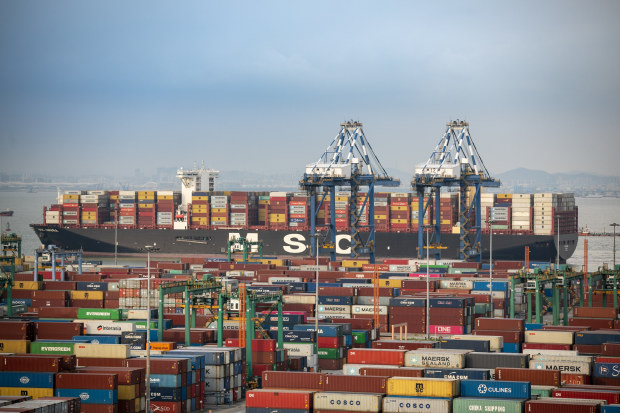‘Unprecedented times’ for ocean freight as fees soar

Ocean freight rates to move containers by sea to Australia are surging because of strong demand for imported goods and materials during the COVID-19 pandemic, creating record profits for shipping lines but intensifying financial pressure on importers.
“The ocean freight market is currently facing unprecedented times with severe capacity and container shortages resulting in overwhelming demand driven by the global pandemic,” logistics group DB Schenker said in an email to customers last week, as it announced higher charges.

Shipping lines are struggling to cope with soaring demand for household goods during the pandemic and are raising prices. Getty
“Shipping lines are continuing to increase freight rates across short and long-term contracts to cope with increasing operational costs and escalating cargo demand.”
Germany’s Hapag-Lloyd will raise fees on containers shipped from Australia to European destinations by $US400 ($544) for every 20-foot equivalent container (TEU) from August 17. This will put the cost of a 40-foot container shipped from Australia to London at $US2350, up from $US1550 previously, a rise of 52 per cent.
Italian-Swiss shipping line Mediterranean Shipping Company has cited the need to “maintain service levels” for raising rates by $US1000 for every refrigerated TEU container that is imported into Australia from the US from September 4.
Denmark’s Maersk sent customers an email last week saying it was introducing “peak season” surcharges for all cargo from Asia including mainland China, Hong Kong and Taiwan to Melbourne, Sydney and Brisbane from August 16. The surcharges range from $US750 to $US1500 a container, depending on its size.
Maersk said it was peak season because customers shipped Christmas supplies from August to October, and demand for shipments to Australia was strong from China and north-east Asia.
“The peak season this year is further impacted as we continue to face a shortage of empty containers due to high market demand, congestion and supply chain bottlenecks, as well as capacity disruption,” a Maersk spokeswoman said.
Maersk’s owner, AP Moller-Maersk, on Friday cited “exceptional circumstances” for its record earnings performance, with profits in its ocean freight business jumping to $US3.6 billion in the second quarter from $US552 million a year earlier. Global container demand is expect to rise 6 per cent to 8 per cent this year, the shipping line said.
The higher rates are reflected in global indices tracking the cost of moving containers around the world.
The Drewry World Container Index rose to $US9371 a 40-foot container for the week to August 5. This is 370 per cent higher than the same week a year ago and the 16th consecutive week of increases.
Another index, the Freightos Baltic Index, which shows spot rates for 40-foot containers moved through some of the world’s biggest shipping lanes, soared to $US10,533 on Friday from $US5443 at the start of June and $US1461 in January 2020.
Kwame Asumadu, director of Victorian-based importer WoodPanels Australia, who has previously called on the federal government to investigate shipping fees, has written to Liberal MP Tim Wilson, chairman of the standing committee on economics, to ask if there was anything the government could do to bring the “insanity” in the shipping sector under control.
Mr Asumadu said the costs of shipping a 40-foot container from New Zealand to Australia had risen by thousands of dollars over the past six months, but because he had fixed contracts with his customers, he could not pass the higher costs on.
He said shipping lines appeared to be rationing space, and the lack of capacity on ships was contributing to the shortage of building materials in Australia.
A spokesman for Shipping Australia, an industry body representing shipping lines and agents, said ocean shipping lines were increasing capacity by ordering new vessels, using multi-purpose vessels to carry containers, and delaying sending vessels to the scrapyard.
“The internationally idle container ship fleet – which had a capacity of about 3 million boxes at the start of the pandemic – has evaporated as all those ships have been put back to work,” the spokesman said.
Subscribe to gift this article
Gift 5 articles to anyone you choose each month when you subscribe.
Subscribe nowAlready a subscriber?
Introducing your Newsfeed
Follow the topics, people and companies that matter to you.
Find out moreRead More
Latest In Transport
Fetching latest articles